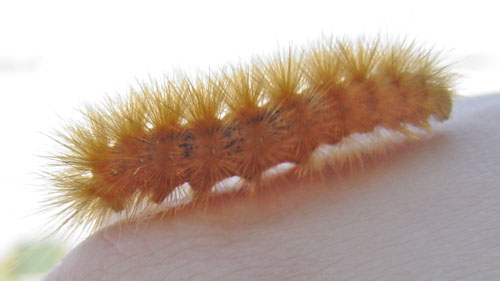[« Eyewitness reports: Socialized Medicine--it ain't bad in Canada at all] [Back in high school, my buddies tried to put the make on anything that moved. I told them, 'Why limit yourselves?'
--Emo Philips »]
09/18/2005: Woolly Bears
Found a Woolly Bear (Pyrrharctia isabella) [or it's most Yellowish cousin] wandering on my deck. Tho' a true Woolly Bear is more orange and has black ends... this one is equally wooly and about two inches long.

This Government webpage say they are found across the United States, Canada, and Mexico. Supposed to cocoon and Metomorphosis into a Tiger Moth. (See pictures on the site.)
But most interesting is the Folk Legends about how Woolly Bears forecast for the severity of the upcoming winter.
Click on the "more" button to read this information.
:-)
"Most people in the Midwest or New England have heard at one time or another that if you want a forecast for the upcoming winter that you should just look for a woolly bear (black at both ends and a reddish brown or rust colored in the middle) or fuzzy bear caterpillar. This same caterpillar is called the woolly worm in southern United States. Yet another name for this caterpillar is the Hedgehog Caterpillar, because it curls into a tight bristly ball and “plays dead” when picked up or disturbed. Whatever name they go by, they are often found in the autumn after they have left their food plants (variety of grasses and weeds including plantain, dandelion, and nettles) in search of a dark and sheltered spot where they can hibernate as larvae for the winter.
According to folklore, the amount of black on the woolly bear in autumn varies proportionately with the severity of the coming winter in the locality where the caterpillar is found. The longer the woolly bear's black bands, the longer, colder, snowier, and more severe the winter will be. Similarly, the wider the middle brown band is associated with a milder upcoming winter. The position of the longest dark bands supposedly indicates which part of winter will be coldest or hardest. If the head end of the caterpillar is dark, the beginning of winter will be severe. If the tail end is dark, the end of winter will be cold. In addition, the woolly bear caterpillar has 13 segments to its body, which traditional forecasters say correspond to the 13 weeks of winter.
As with most folklore, there are 2 other versions to this story. The first one says that the woolly bear caterpillar's coat will indicate the upcoming winter's severity. So, if its coat is very woolly, it will be a cold winter. The final version deals with the woolly bear caterpillar's direction of travel of the worms. It is said that woolly bear's crawling in a southerly direction are trying to escape the cold winter conditions of the north. On the other hand, woolly bear's crawling on a northward path would indicate a mild winter.
The popularity of the woolly bear caterpillar has resulted in several festivals honoring them. In Vermilion Ohio (east of Cleveland), the residents hold the annual "Woolly Bear Festival". It is claimed to be the largest one-day festival in Ohio. Festivities include a parade, woolly bear races and an "official" analysis of the woolly bears and forecast for the coming winter. Also, every 3rd weekend in October the annual Woolly Worm Festival in Banner Elk, NC. They begin worm their worm races around 10:20 AM, or as soon as the first heat, on Saturday morning. Races continue all day until the grand final about 4 PM when the champion worm and trainer is crowned (and paid!). At that time the official winter forecast will be declared. Sunday worm races are for fun and small prizes and will continue throughout the day as long as there are race participants.
Even though it is widely believed that the woolly bear caterpillar can predict the upcoming winter's severity, the truth is that this caterpillar can't predict what Old Man Winter has in store for us in the upcoming winter. The woolly bear caterpillar's coloring is based on how long caterpillar has been feeding, its age, and species. The better the growing season is the bigger it will grow. This results in a narrower red-orange bands in its middle. Thus, the width of the banding is an indicator of the current or past season's growth rather than an indicator of the severity of the upcoming winter. Also, the coloring indicates the age of the woolly bear caterpillar. The caterpillars shed their skins or molt six times before reaching adult size. With each successive molt, their colors change, becoming less black and more reddish. In addition, there are approximately 260 species of tiger moths (the adult of the woolly bear caterpillar) in North America, and each species has slightly different color patterns and hair coverings. As a result, some of the color variations that we see each fall may be just a result of seeing a different species."
Karen on 09.18.05 @ 01:00 PM CST










